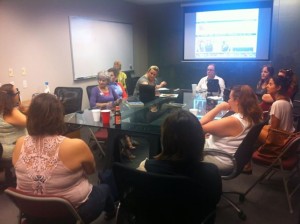FemTechNet at Brown University, 2013
By Meg Fernandes
The FemTechNet seminar at Brown University has had an exciting and productive semester thus far! The class is composed of both graduate and undergraduate students interested in a wide variety of issues related to feminism and technology including electronic art projects, new media theory, and feminist pedagogy. In addition to a rigorous curriculum of readings, our course assignments and events include wiki-editing, keyword video production, creative assignments, student reflections about “feminist” terminology, and a guest lecture series. Please visit our course website here (and check back for updates!):
On October 15th (Ada Lovelace Day), our FemTechNet class participated in a campus wide wiki-editing event. The event was led by Maia Weinstock of Wikimedia New England as well as Professor Anne Fausto Sterling. Together, participants edited 70 existing articles and added 20 new articles about prominent female scientists, engineers, and other important cultural figures. The event was covered by a number of local press publications.
FemTechNet students are also making their own keyword videos around topics of their choice which have thus far included Agency, Performance, Cyberfeminism, and Women-Only Art Spaces. We are currently in the stage of post-production, but we hope to have the videos uploaded by the end of November. The videos emphasize student interests related to the course readings including analyzing computer music composition/innovation, investigating technologies such as Snapchat and Siri, and discussing the labors of bodily and opensignal performance. Students will also be completing creative assignments at the end of the year which will include, zines, photography projects, documentary work, poetry, etc. A summary will be written up at the end of the semester.
Students continue to write reflections about terms such as Stacy Alaimo’s “trans-corporeality,” Priscilla Wald’s “outbreak narrative,” and contemporary events related to issues on feminism and technology such as the Hysterical Women’s Project and subRosa. Some of our most interesting discussions have been around Wendy Chun’s work on software, Judith Butler’s essay on vulnerability and mourning, Eugene Thacker’s “biomedia,” Mel Y Chen’s “animacy,” and Melinda Cooper and Kalinda Vora’s discussion of transnational reproductive labor and technology.
Lastly, we are hosting a number of exciting guest lectures including video artists, animators, and DJ’ s, including the following:
Asha Tamirisia, graduate student in MEME (computer music) at Brown University
Asha gave a presentation on her role as a computer music artist, tracing her development and interests in both analog and digital music production through her childhood, her undergraduate education at Oberlin, and finally, her work here at Brown as a PhD student. About one of the videos she showed, which can be found on our course website, she said:
This project was made in collaboration with dancer Alayna Wiley in 2010 in an old, unused men’s locker room at Oberlin College. The movement and video processing hinge on ideas of disappearance, intangibility, and distortion. As I revisit this project many years later, I see ties to ideas of material feminism: a means to create the sensation of porousness between the body and its environment, reconceiving the body in a way that recognizes it as a place in process.
Jessamyn Swift, graduate student in English at Brown University
Jessamyn gave her presentation on her evolving dissertation research including investigating theories of agency and the nonhuman in the work of Charles Darwin. In particular, Jessamyn close-read sections of Darwin’s observations about the possible “sentient” or “intentional” behavior of certain organisms including worms.
Samantha Calamari, DJ and Instructional Technology Expert and Aaron Apps, graduate student in English at Brown University.
Samantha will be presenting about her career as a female DJ in the 90′s in San Francisco and New York City. In particular, Samantha remarks on how the change from analog to digital DJ technologies changed the gender landscape in music culture.
Aaron is a published poet. He will be presenting work on his poetry book, Intersex, and discuss issues of queer identity and gender politics.
Elisa Giardina Papa, digital artist, Rhode Island School of Design and Brown University
Elisa is an Italian digital artist. She will presenting her work on animation and portraiture.
November 26th, 2013: Maura Smyth, Junior Fellow at Harvard University’s Society of Fellows
Maura is giving a presentation about her co-founded digital collaborative story-telling project called The Blaitholm Affair. From the press release:
The Blaitholm Affair’s interface will seamlessly integrate the world’s stories, art, and music, enabling artistic collaboration and allowing each visitor to have a different experience of the world, depending on how you navigate it… The scope of the world is boundless, the opportunities for collaboration never-ending.
December 3rd, 2013: Malavika Jayaram, Fellow at Harvard University’s Berkman Center for Internet and Society
From her website:
Malavika works broadly in the areas of privacy, identity, free expression and internet policy in India. A practicing lawyer specializing in technology law, she has a particular interest in new media and the arts, and has advised start-ups, innovators, scientists, educational institutions and artists. A Fellow at the Centre for Internet and Society in Bangalore, India, she follows legislative and policy developments in the privacy and internet governance domains. For the last few years, she has been looking at he evolution of big data and e-governance projects in India – particularly the world’s largest biometric ID project – and their implications for identity, freedom, choice and informational self-determination.






